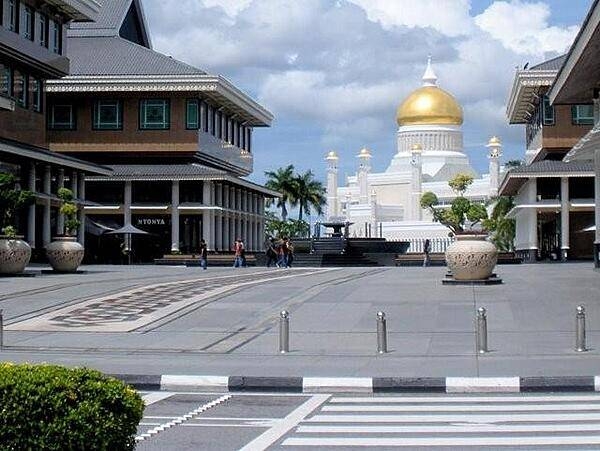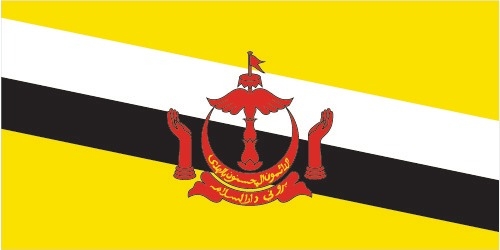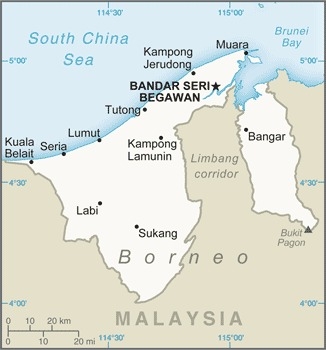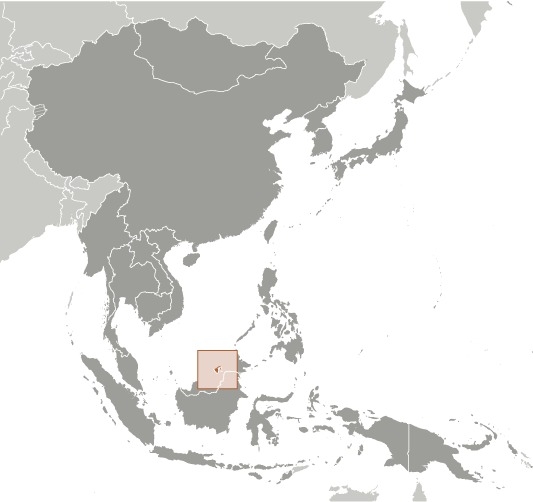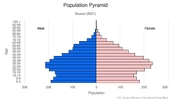Introduction
Background
The Sultanate of Brunei's influence peaked between the 15th and 17th centuries when its control extended over coastal areas of northwest Borneo and the southern Philippines. Brunei subsequently entered a period of decline brought on by internal strife over royal succession, colonial expansion of European powers, and piracy. In 1888, Brunei became a British protectorate; independence was achieved in 1984. The same family has ruled Brunei for over six centuries. Brunei benefits from extensive petroleum and natural gas fields, the source of one of the highest per capita GDPs in the world. In 2017, Brunei celebrated the 50th anniversary of the Sultan Hassanal BOLKIAH’s accession to the throne.
Visit the Definitions and Notes page to view a description of each topic.
Geography
Location
Southeastern Asia, along the northern coast of the island of Borneo, bordering the South China Sea and Malaysia
Geographic coordinates
4 30 N, 114 40 E
Map references
Southeast Asia
Land boundaries
total: 266 km
border countries (1): Malaysia 266 km
Coastline
161 km
Maritime claims
territorial sea: 12 nm
exclusive economic zone: 200 nm or to median line
Climate
tropical; hot, humid, rainy
Terrain
flat coastal plain rises to mountains in east; hilly lowland in west
Elevation
highest point: Bukit Pagon 1,850 m
lowest point: South China Sea 0 m
mean elevation: 478 m
Natural resources
petroleum, natural gas, timber
Land use
agricultural land: 2.5% (2018 est.)
arable land: 0.8% (2018 est.)
permanent crops: 1.1% (2018 est.)
permanent pasture: 0.6% (2018 est.)
forest: 71.8% (2018 est.)
other: 25.7% (2018 est.)
Irrigated land
10 sq km (2012)
Natural hazards
typhoons, earthquakes, and severe flooding are rare
Geography - note
close to vital sea lanes through South China Sea linking Indian and Pacific Oceans; two parts physically separated by Malaysia; the eastern part, the Temburong district, is an exclave and is almost an enclave within Malaysia
People and Society
Population
471,103 (July 2021 est.)
note: immigrants make up approximately 26% of the total population, according to UN data (2019)
Nationality
noun: Bruneian(s)
adjective: Bruneian
Ethnic groups
Malay 65.8%, Chinese 10.2%, other 24% (2020 est.)
Languages
Malay (Bahasa Melayu) (official), English, Chinese dialects
major-language sample(s):
Buku Fakta Dunia, sumber yang diperlukan untuk maklumat asas. (Malay)
The World Factbook, the indispensable source for basic information.
Religions
Muslim (official) 80.9%, Christian 7.1%, Buddhist 7.1%, other (includes indigenous beliefs) 5% (2016 est.)
Demographic profile
Brunei is a small, oil-rich sultanate of less than half a million people, making it the smallest country in Southeast Asia by population. Its total fertility rate – the average number of births per woman – has been steadily declining over the last few decades, from over 3.5 in the 1980s to below replacement level today at nearly 1.8. The trend is due to women’s increased years of education and participation in the workforce, which have resulted in later marriages and fewer children. Yet, the population continues to grow because of the large number of women of reproductive age and a reliance on foreign labor – mainly from Malaysia, Thailand, the Philippines, Indonesia, and South Asian countries – to fill low-skilled jobs.
Brunei is officially Muslim, and Malay is the official language. The country follows an official Malay national ideology, Malay Islamic Monarchy, which promotes Malay language and culture, Islamic values, and the monarchy. Only seven of Brunei’s native groups are recognized in the constitution and are defined as “Malay” – Brunei Malays, Belait, Kedayan, Dusun, Bisayak, Lun Bawang, and Sama-Baiau. Together they make up about 66% percent of the population and are referred to as the Bumiputera. The Bumiputera are entitled to official privileges, including land ownership, access to certain types of employment (Royal Brunei Armed Forces and Brunei Shell Petroleum), easier access to higher education, and better job opportunities in the civil service.
Brunei’s Chinese population descends from migrants who arrived when Brunei was a British protectorate (1888 and 1984). They are prominent in the non-state commercial sector and account for approximately 10% of the population. Most Bruneian Chinese are permanent residents rather than citizens despite roots going back several generations. Many are stateless and are denied rights granted to citizens, such as land ownership, subsidized health care, and free secondary and university education. Because of the discriminatory policies, the number of Chinese in Brunei has shrunk considerably in the last 50 years. Native ethnic groups that are not included in the Bumiputera are not recognized in the constitution and are not officially identified as “Malay” or automatically granted citizenship. Foreign workers constitute some quarter of the labor force.
Age structure
0-14 years: 22.41% (male 53,653/female 50,446)
15-24 years: 16.14% (male 37,394/female 37,559)
25-54 years: 47.21% (male 103,991/female 115,291)
55-64 years: 8.34% (male 19,159/female 19,585)
65 years and over: 5.9% (male 13,333/female 14,067) (2020 est.)
Dependency ratios
total dependency ratio: 38.7
youth dependency ratio: 31
elderly dependency ratio: 7.7
potential support ratio: 12.9 (2020 est.)
Median age
total: 31.1 years
male: 30.5 years
female: 31.8 years (2020 est.)
Urbanization
urban population: 78.6% of total population (2021)
rate of urbanization: 1.44% annual rate of change (2020-25 est.)
Major urban areas - population
241,000 BANDAR SERI BEGAWAN (capital) (2011)
note: the boundaries of the capital city were expanded in 2007, greatly increasing the city area; the population of the capital increased tenfold
Sex ratio
at birth: 1.05 male(s)/female
0-14 years: 1.06 male(s)/female
15-24 years: 1 male(s)/female
25-54 years: 0.9 male(s)/female
55-64 years: 0.98 male(s)/female
65 years and over: 0.95 male(s)/female
total population: 0.96 male(s)/female (2020 est.)
Maternal mortality ratio
31 deaths/100,000 live births (2017 est.)
country comparison to the world: 109Infant mortality rate
total: 10.79 deaths/1,000 live births
male: 13.21 deaths/1,000 live births
female: 8.25 deaths/1,000 live births (2021 est.)
Life expectancy at birth
total population: 78.14 years
male: 75.75 years
female: 80.63 years (2021 est.)
Drinking water source
improved: total: 100% of population
unimproved: total: 0% of population (2017 est.)
Current Health Expenditure
2.4% (2018)
Physicians density
1.61 physicians/1,000 population (2017)
Hospital bed density
2.9 beds/1,000 population (2017)
Literacy
definition: age 15 and over can read and write
total population: 97.2%
male: 98.1%
female: 93.4% (2018)
School life expectancy (primary to tertiary education)
total: 14 years
male: 14 years
female: 14 years (2020)
Unemployment, youth ages 15-24
total: 21.4%
male: 19%
female: 25.8% (2019 est.)
Environment
Environment - current issues
no major environmental problems, but air pollution control is becoming a concern; seasonal trans-boundary haze from forest fires in Indonesia
Environment - international agreements
party to: Biodiversity, Climate Change, Climate Change-Kyoto Protocol, Climate Change-Paris Agreement, Comprehensive Nuclear Test Ban, Desertification, Endangered Species, Hazardous Wastes, Law of the Sea, Ozone Layer Protection, Ship Pollution
signed, but not ratified: none of the selected agreements
Air pollutants
particulate matter emissions: 5.78 micrograms per cubic meter (2016 est.)
carbon dioxide emissions: 7.66 megatons (2016 est.)
methane emissions: 8.4 megatons (2020 est.)
Climate
tropical; hot, humid, rainy
Land use
agricultural land: 2.5% (2018 est.)
arable land: 0.8% (2018 est.)
permanent crops: 1.1% (2018 est.)
permanent pasture: 0.6% (2018 est.)
forest: 71.8% (2018 est.)
other: 25.7% (2018 est.)
Urbanization
urban population: 78.6% of total population (2021)
rate of urbanization: 1.44% annual rate of change (2020-25 est.)
Revenue from forest resources
forest revenues: 0.05% of GDP (2018 est.)
country comparison to the world: 127Waste and recycling
municipal solid waste generated annually: 216,253 tons (2016 est.)
Total water withdrawal
municipal: 151.5 million cubic meters (2017 est.)
agricultural: 5.3 million cubic meters (2017 est.)
Total renewable water resources
8.5 billion cubic meters (2017 est.)
Government
Country name
conventional long form: Brunei Darussalam
conventional short form: Brunei
local long form: Negara Brunei Darussalam
local short form: Brunei
etymology: derivation of the name is unclear; according to legend, MUHAMMAD SHAH, who would become the first sultan of Brunei, upon discovering what would become Brunei exclaimed "Baru nah," which roughly translates as "there" or "that's it"
Government type
absolute monarchy or sultanate
Capital
name: Bandar Seri Begawan
geographic coordinates: 4 53 N, 114 56 E
time difference: UTC+8 (13 hours ahead of Washington, DC, during Standard Time)
etymology: named in 1970 after Sultan Omar Ali SAIFUDDIEN III (1914-1986; "The Father of Independence") who adopted the title of "Seri Begawan" (approximate meaning "honored lord") upon his abdication in 1967; "bandar" in Malay means "town" or "city"; the capital had previously been called Bandar Brunei (Brunei Town)
Administrative divisions
4 districts (daerah-daerah, singular - daerah); Belait, Brunei dan Muara, Temburong, Tutong
Independence
1 January 1984 (from the UK)
National holiday
National Day, 23 February (1984); note - 1 January 1984 was the date of independence from the UK, 23 February 1984 was the date of independence from British protection; the Sultan's birthday, 15 June
Constitution
history: drafted 1954 to 1959, signed 29 September 1959; note - some constitutional provisions suspended since 1962 under a State of Emergency, others suspended since independence in 1984
amendments: proposed by the monarch; passage requires submission to the Privy Council for Legislative Council review and finalization takes place by proclamation; the monarch can accept or reject changes to the original proposal provided by the Legislative Council; amended several times, last in 2010
Legal system
mixed legal system based on English common law and Islamic law; note - in April 2019, the full sharia penal codes came into force and apply to Muslims and non-Muslims in parallel with present common law codes
International law organization participation
has not submitted an ICJ jurisdiction declaration; non-party state to the ICC
Citizenship
citizenship by birth: no
citizenship by descent only: the father must be a citizen of Brunei
dual citizenship recognized: no
residency requirement for naturalization: 12 years
Suffrage
18 years of age for village elections; universal
Executive branch
chief of state: Sultan and Prime Minister Sir HASSANAL Bolkiah (since 5 October 1967); note - the monarch is both chief of state and head of government
head of government: Sultan and Prime Minister Sir HASSANAL Bolkiah (since 5 October 1967)
cabinet: Council of Ministers appointed and presided over by the monarch; note(s)- 4 additional advisory councils appointed by the monarch are the Religious Council, Privy Council for constitutional issues, Council of Succession, and Legislative Council; Sultan and Prime Minister Sir HASSANAL Bolkiah is also Minister of Finance, Defense, and Foreign Affairs and Trade
elections/appointments: none; the monarchy is hereditary
Legislative branch
description: unicameral Legislative Council or Majlis Mesyuarat Negara Brunei (33 seats; 20 members appointed by the sultan from ex-officio cabinet ministers, titled people, and prominent citizens in public service and various professional fields and 13 members from 4 multi-seat constituencies, and 3 ex-officio members - the speaker and first and second secretaries
elections: appointed by the sultan
election results: NA; composition (as of July 2021) - men 30, women 3, percent of women 9.1%
Judicial branch
highest courts: Supreme Court (consists of the Court of Appeal and the High Court, each with a chief justice and 2 judges); Sharia Court (consists the Court of Appeals and the High Court); note - Brunei has a dual judicial system of secular and sharia (religious) courts; the Judicial Committee of Privy Council (in London) serves as the final appellate court for civil cases only
judge selection and term of office: Supreme Court judges appointed by the monarch to serve until age 65, and older if approved by the monarch; Sharia Court judges appointed by the monarch for life
subordinate courts: Intermediate Court; Magistrates' Courts; Juvenile Court; small claims courts; lower sharia courts
Political parties and leaders
National Development Party or NDP [YASSIN Affendi]
note: Brunei National Solidarity Party or PPKB [Abdul LATIF bin Chuchu] and People's Awareness Party or PAKAR [Awang Haji MAIDIN bin Haji Ahmad] were deregistered in 2007; parties are small and have limited activity
International organization participation
ADB, APEC, ARF, ASEAN, C, CP, EAS, FAO, G-77, IAEA, IBRD, ICAO, ICC (NGOs), ICRM, IDA, IFRCS, ILO, IMF, IMO, IMSO, Interpol, IOC, ISO (correspondent), ITSO, ITU, NAM, OIC, OPCW, UN, UNCTAD, UNESCO, UNIFIL, UNWTO, UPU, WCO, WHO, WIPO, WMO, WTO
Diplomatic representation in the US
chief of mission: Ambassador Dato Paduka Haji Serbini bin Haji ALI (since 28 January 2016)
chancery: 3520 International Court NW, Washington, DC 20008
telephone: [1] (202) 237-1838
FAX: [1] (202) 885-0560
email address and website:
info@bruneiembassy.org
http://www.bruneiembassy.org/index.html
consulate(s): New York
Diplomatic representation from the US
chief of mission: Ambassador (vacant); Charge d'Affaires Emily M. FLECKNER (since 20 August 2020)
embassy: Simpang 336-52-16-9, Jalan Duta, Bandar Seri Begawan, BC4115
mailing address: 4020 Bandar Seri Begawan Place, Washington DC 20521-4020
telephone: (673) 238-7400
FAX: (673) 238-7533
email address and website:
ConsularBrunei@state.gov
https://bn.usembassy.gov/
Flag description
yellow with two diagonal bands of white (top, almost double width) and black starting from the upper hoist side; the national emblem in red is superimposed at the center; yellow is the color of royalty and symbolizes the sultanate; the white and black bands denote Brunei's chief ministers; the emblem includes five main components: a swallow-tailed flag, the royal umbrella representing the monarchy, the wings of four feathers symbolizing justice, tranquility, prosperity, and peace, the two upraised hands signifying the government's pledge to preserve and promote the welfare of the people, and the crescent moon denoting Islam, the state religion; the state motto "Always render service with God's guidance" appears in yellow Arabic script on the crescent; a ribbon below the crescent reads "Brunei, the Abode of Peace"
National symbol(s)
royal parasol; national colors: yellow, white, black
National anthem
name: "Allah Peliharakan Sultan" (God Bless His Majesty)
lyrics/music: Pengiran Haji Mohamed YUSUF bin Pengiran Abdul Rahim/Awang Haji BESAR bin Sagap
note: adopted 1951
Economy
Economic overview
Brunei is an energy-rich sultanate on the northern coast of Borneo in Southeast Asia. Brunei boasts a well-educated, largely English-speaking population; excellent infrastructure; and a stable government intent on attracting foreign investment. Crude oil and natural gas production account for approximately 65% of GDP and 95% of exports, with Japan as the primary export market.
Per capita GDP is among the highest in the world, and substantial income from overseas investment supplements income from domestic hydrocarbon production. Bruneian citizens pay no personal income taxes, and the government provides free medical services and free education through the university level.
The Bruneian Government wants to diversify its economy away from hydrocarbon exports to other industries such as information and communications technology and halal manufacturing, permissible under Islamic law. Brunei’s trade increased in 2016 and 2017, following its regional economic integration in the ASEAN Economic Community, and the expected ratification of the Trans-Pacific Partnership trade agreement.
Real GDP (purchasing power parity)
$27.23 billion note: data are in 2017 dollars (2020 est.)
$26.91 billion note: data are in 2017 dollars (2019 est.)
$25.9 billion note: data are in 2017 dollars (2018 est.)
note: data are in 2017 dollars
Real GDP growth rate
1.3% (2017 est.)
-2.5% (2016 est.)
-0.4% (2015 est.)
Real GDP per capita
$62,200 note: data are in 2017 dollars (2020 est.)
$62,100 note: data are in 2017 dollars (2019 est.)
$60,400 note: data are in 2017 dollars (2018 est.)
note: data are in 2017 dollars
GDP (official exchange rate)
$12.13 billion (2017 est.)
Inflation rate (consumer prices)
-0.2% (2017 est.)
-0.7% (2016 est.)
GDP - composition, by sector of origin
agriculture: 1.2% (2017 est.)
industry: 56.6% (2017 est.)
services: 42.3% (2017 est.)
GDP - composition, by end use
household consumption: 25% (2017 est.)
government consumption: 24.8% (2017 est.)
investment in fixed capital: 32.6% (2017 est.)
investment in inventories: 8.5% (2017 est.)
exports of goods and services: 45.9% (2017 est.)
imports of goods and services: -36.8% (2017 est.)
Agricultural products
poultry, eggs, fruit, cassava, bananas, legumes, cucumbers, rice, pineapples, beef
Industries
petroleum, petroleum refining, liquefied natural gas, construction, agriculture, aquaculture, transportation
Labor force - by occupation
agriculture: 4.2%
industry: 62.8%
services: 33% (2008 est.)
Household income or consumption by percentage share
lowest 10%: NA
highest 10%: NA
Budget
revenues: 2.245 billion (2017 est.)
expenditures: 4.345 billion (2017 est.)
Fiscal year
1 April - 31 March
Current account balance
$2.021 billion (2017 est.)
$1.47 billion (2016 est.)
Exports
$7.83 billion note: data are in current year dollars (2019 est.)
$7.04 billion note: data are in current year dollars (2018 est.)
Exports - partners
Japan 34%, Australia 12%, Singapore 10%, India 8%, Malaysia 8%, Thailand 7%, China 6%, South Korea 5% (2019)
Exports - commodities
natural gas, crude petroleum, refined petroleum, industrial alcohols, industrial hydrocarbons (2019)
Imports
$6.81 billion note: data are in current year dollars (2019 est.)
$5.68 billion note: data are in current year dollars (2018 est.)
Imports - partners
Singapore 18%, China 14%, Malaysia 12%, Nigeria 5%, United Arab Emirates 5%, United States 5% (2019)
Imports - commodities
crude petroleum, refined petroleum, cars, tug boats, valves (2019)
Reserves of foreign exchange and gold
$3.488 billion (31 December 2017 est.)
$3.366 billion (31 December 2015 est.)
Debt - external
$0 (2014)
$0 (2013)
note: public external debt only; private external debt unavailable
Exchange rates
Bruneian dollars (BND) per US dollar -
1.33685 (2020 est.)
1.35945 (2019 est.)
1.3699 (2018 est.)
1.3749 (2014 est.)
1.267 (2013 est.)
Unemployment, youth ages 15-24
total: 21.4%
male: 19%
female: 25.8% (2019 est.)
Energy
Electricity access
electrification - total population: 100% (2020)
Electricity - installed generating capacity
821,000 kW (2016 est.)
country comparison to the world: 134Electricity - from fossil fuels
100% of total installed capacity (2016 est.)
country comparison to the world: 5Electricity - from nuclear fuels
0% of total installed capacity (2017 est.)
country comparison to the world: 56Electricity - from hydroelectric plants
0% of total installed capacity (2017 est.)
country comparison to the world: 161Electricity - from other renewable sources
0% of total installed capacity (2017 est.)
country comparison to the world: 178Refined petroleum products - production
10,310 bbl/day (2015 est.)
country comparison to the world: 100Refined petroleum products - consumption
18,000 bbl/day (2016 est.)
country comparison to the world: 144Natural gas - proved reserves
260.5 billion cu m (1 January 2018 est.)
country comparison to the world: 39Communications
Telephones - fixed lines
total subscriptions: 103,885 (2020)
subscriptions per 100 inhabitants: 23.75 (2020 est.)
Telephones - mobile cellular
total subscriptions: 526,732 (2020)
subscriptions per 100 inhabitants: 120.4 (2020 est.)
Telecommunication systems
general assessment: Brunei is improving its national telecom network; telecommunications infrastructure and services are of high standard, due to healthy investment in networks and services; relatively mature telecom system compared to other Asian countries; mobile subscription increasing steadily to high penetration; launch of 5G pilot services in April 2021 aimed to increase awareness of the benefits of 5G and boost the mobile broadband sector; access to telecom services via the Kacific-1 satellite (2021)
domestic: every service available; 20 per 100 fixed-line, 129 per 100 mobile-cellular (2019)
international: country code - 673; landing points for the SEA-ME-WE-3, SJC, AAG, Lubuan-Brunei Submarine Cable via optical telecommunications submarine cables that provides links to Asia, the Middle East, Southeast Asia, Africa, Australia, and the US; satellite earth stations - 2 Intelsat (1 Indian Ocean and 1 Pacific Ocean) (2019)
note: the COVID-19 pandemic continues to have a significant impact on production and supply chains globally; since 2020, some aspects of the telecom sector have experienced downturn, particularly in mobile device production; many network operators delayed upgrades to infrastructure; progress towards 5G implementation was postponed or slowed in some countries; consumer spending on telecom services and devices was affected by large-scale job losses and the consequent restriction on disposable incomes; the crucial nature of telecom services as a tool for work and school from home became evident, and received some support from governments
Broadcast media
state-controlled Radio Television Brunei (RTB) operates 5 channels; 3 Malaysian TV stations are available; foreign TV broadcasts are available via satellite systems; RTB operates 5 radio networks and broadcasts on multiple frequencies; British Forces Broadcast Service (BFBS) provides radio broadcasts on 2 FM stations; some radio broadcast stations from Malaysia are available via repeaters
Internet users
total: 417,500 (2021 est.)
percent of population: 95% (2019 est.)
Broadband - fixed subscriptions
total: 71,078 (2020)
subscriptions per 100 inhabitants: 16.25 (2020 est.)
Transportation
National air transport system
number of registered air carriers: 1 (2020)
inventory of registered aircraft operated by air carriers: 10
annual passenger traffic on registered air carriers: 1,234,455 (2018)
annual freight traffic on registered air carriers: 129.35 million mt-km (2018)
Airports - with paved runways
total: 1
over 3,047 m: 1 (2019)
Heliports
3 (2013)
Pipelines
33 km condensate, 86 km condensate/gas, 628 km gas, 492 km oil (2013)
Roadways
total: 2,976 km (2014)
paved: 2,559 km (2014)
unpaved: 417 km (2014)
Waterways
209 km (navigable by craft drawing less than 1.2 m; the Belait, Brunei, and Tutong Rivers are major transport links) (2012)
country comparison to the world: 96Merchant marine
total: 96
by type: general cargo 18, oil tanker 3, other 75 (2021)
Ports and terminals
major seaport(s): Muara
oil terminal(s): Lumut, Seria
LNG terminal(s) (export): Lumut
Military and Security
Military and security forces
Royal Brunei Armed Forces: Royal Brunei Land Force, Royal Brunei Navy, Royal Brunei Air Force (2021)
Military expenditures
3.7% of GDP (2020 est.)
3.3% of GDP (2019)
2.6% of GDP (2018)
2.9% of GDP (2017)
3.5% of GDP (2016)
Military and security service personnel strengths
the Royal Brunei Armed Forces is comprised of approximately 6,500 total active troops (4,500 Army; 1,000 Navy; 1,000 Air Force) (2021)
Military equipment inventories and acquisitions
the Royal Brunei Armed Forces imports nearly all of its military equipment and weapons systems; suppliers since 2010 include France, Germany, Singapore, Sweden, and the US (2021)
Military service age and obligation
17 years of age for voluntary military service; non-Malays are ineligible to serve; recruits from the army, navy, and air force all undergo 43-week initial training (2021)
Military - note
Transnational Issues
Disputes - international
per Letters of Exchange signed in 2009, Malaysia in 2010 ceded two hydrocarbon concession blocks to Brunei in exchange for Brunei's sultan dropping claims to the Limbang corridor, which divides Brunei; nonetheless, Brunei claims a maritime boundary extending as far as a median with Vietnam, thus asserting an implicit claim to Louisa Reef
Refugees and internally displaced persons
stateless persons: 20,863 (2020); note - thousands of stateless persons, often ethnic Chinese, are permanent residents and their families have lived in Brunei for generations; obtaining citizenship is difficult and requires individuals to pass rigorous tests on Malay culture, customs, and language; stateless residents receive an International Certificate of Identity, which enables them to travel overseas; the government is considering changing the law prohibiting non-Bruneians, including stateless permanent residents, from owning land
Trafficking in persons
current situation: human traffickers exploit foreign victims in Brunei; some men and women who migrate to Brunei to work as domestics or in retail or construction are subject to involuntary servitude, debt-based coercion, contract switching, non-payment of wages, passport confiscation, physical abuse, or confinement; some female migrants entering Brunei on tourist visas are forced into prostitution; some traffickers use Brunei as a transit point for victims used for sex and labor trafficking in Malaysia and Indonesia
tier rating: Tier 2 Watch List — Brunei does not fully meet the minimum standards for the elimination of trafficking but is making significant efforts to do so; the government enacted the 2019 Trafficking in Persons Order, which criminalized sex and labor trafficking and separated trafficking crimes from migrant smuggling crimes; the government formalized its interagency anti-trafficking in persons committee; instituted a committee to review foreign worker recruitment practices, ratified the ASEAN Convention against Trafficking in Persons, and acceded to the UN TIP Protocol; however, authorities did not formally identify any trafficking cases, did not initiate any new trafficking prosecutions, and did not convict any traffickers; trafficking victims continued to be detained, deported, and charged with crimes without law enforcement determining if they were forced to commit the illegal acts by traffickers; the government again did not allocate money to a fund established in 2004 for victim compensation and repatriation; a draft national action plan to combat trafficking was not completed for the sixth consecutive year (2020)
Illicit drugs
drug trafficking and illegally importing controlled substances are serious offenses in Brunei and carry a mandatory death penalty
